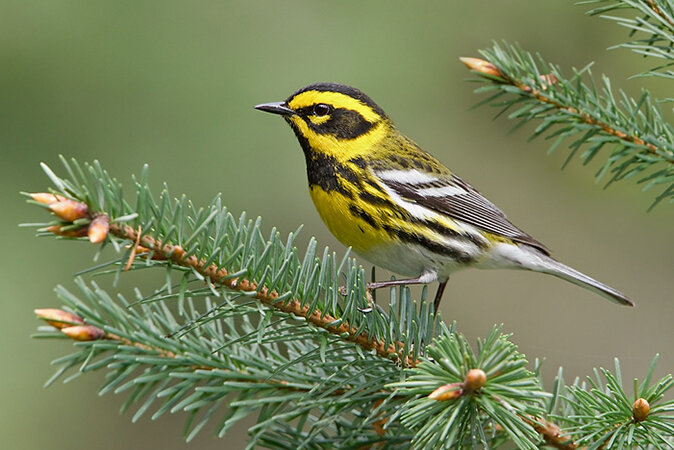January Nature Almanac: A Confusion of Warblers
By Ruth Carol Cushman, with Stephen Jones and Scott Severs
January 2023
Popular English collective nouns for warblers include a “bouquet,” a “fall,” or a “wrench” of warblers. Or—most apt for Colorado this past autumn—a confusion of warblers. What were those tiny bits of fluff thinking when they settled down here in November instead of migrating south? In fact, why were these mostly eastern birds here anyway?
Entomologist David Leatherman (you may know him from his witty posts to COBirds, the online group/listserv for the Colorado Field Ornithologists) poses a lot of questions. Were they mostly first-time migrants from late-starting first or second nests? Was their navigation sense just not wired correctly? Are some birds simply procrastinators? Or are more late migrants surviving than would have been the case “in the old days” because current late autumn weather tends to be milder? Is there more available food because of urban plantings? Are there just more birdwatchers out looking for birds than in the past and so we think there are more warblers than in the past? More questions than answers. Seems like there are lots of research ideas here.
A factor may be the exceptional drought that occurred this year along traditional migration routes in eastern North America and impacted food resources. Poorly nourished birds may have been forced off their usual routes to linger here while they fatten up for their long trip south. Suet feeders and an abundance of fruit on Russian-olive trees, viburnums, mountain ashes, crabapples, and junipers may also have enticed the omnivorous warblers to stick around.
Additionally, ornithologists are becoming increasingly concerned about excessive urban and suburban lighting that adds to the confusion of night migrating warblers (and other species) who largely navigate by the stars.
Here in Boulder, there was an outstanding hotspot between a European beech and a white swamp oak near Regent Hall on the University of Colorado campus. The attraction was an abundance of aphids, leaf-sucking insects hated by gardeners but loved by mostly insectivorous warblers who flew back and forth between the beech and the oak. For some reason the warblers found the aphids on the undersides of the beech leaves especially desirable prompting another question: are beech aphids more delectable than others? Taste test, anyone?
For several weeks, folks with binoculars hung out near the trees comparing notes and generously helping others see Northern Parula, Prothonotary, Nashville, Palm, and Pine warblers. They probably also turned several passersby onto the joy of birding, especially the joy (and frustration) of warbler watching.
Birdwatchers are mesmerized by brightly colored (lots of yellow!) warblers. The elusive birds like to twitter around in the treetops where seeing them in yellow, green, and tan foliage is a challenge. Perhaps that challenge is part of their popularity. To our joy, Mountain Bluebirds also lingered near the base of the foothills, remaining active into December.
By the end of November, we no longer found aphids on the beech leaves and assumed they perished when temperatures finally dipped into the 20s. Most warblers were also gone, winging their way down to Mexico or Central America, we hope.
No rare warblers were still here for the annual Boulder Audubon Christmas Bird Count. Compiler Bill Schmoker reported only Yellow-rumped Warblers on December 18, the actual count day, with an Orange-crowned Warbler sighted during count week. On December 17, however, the Denver count recorded a Nashville Warbler, a first for their 67-year count.
The list below, which may not be complete, includes 22 warblers reported in Colorado since the first of November 2022. The more common species known to breed in the state are marked with an asterisk: Bay-breasted, Black-and-white, Black-throated Blue, Blackpoll, Chestnut-sided, Hooded, MacGillivray's*, Nashville, Orange-crowned*, Palm, Pine, Prothonotary, Tennessee, Townsend's, Wilson's*, Yellow*, Yellow-rumped*, and Yellow-throated Warbler, along with Common Yellowthroat*, Northern Parula, Northern Waterthrush, and Ovenbird*.
Other January Events
Listen for a few hardy birds that sing in winter, usually in defense of a feeding territory. Townsend’s Solitaires often trill from the tops of berry-laden junipers, and American Dippers often sing while perched on a rock in a turbulent creek where they forage for invertebrates.
Coyotes court and breed from January to March. Watch for them racing about in the snow and rising on their hind legs to touch forepaws.
Many black bears were late to hibernate this year, possibly due to a warm autumn and an abundance of fruit. Does this sound like the same scenario that may have affected warbler migration? We hope that by now the cubs--born while their mother is deep in hibernation--are snuggled up with her in warm dens.


